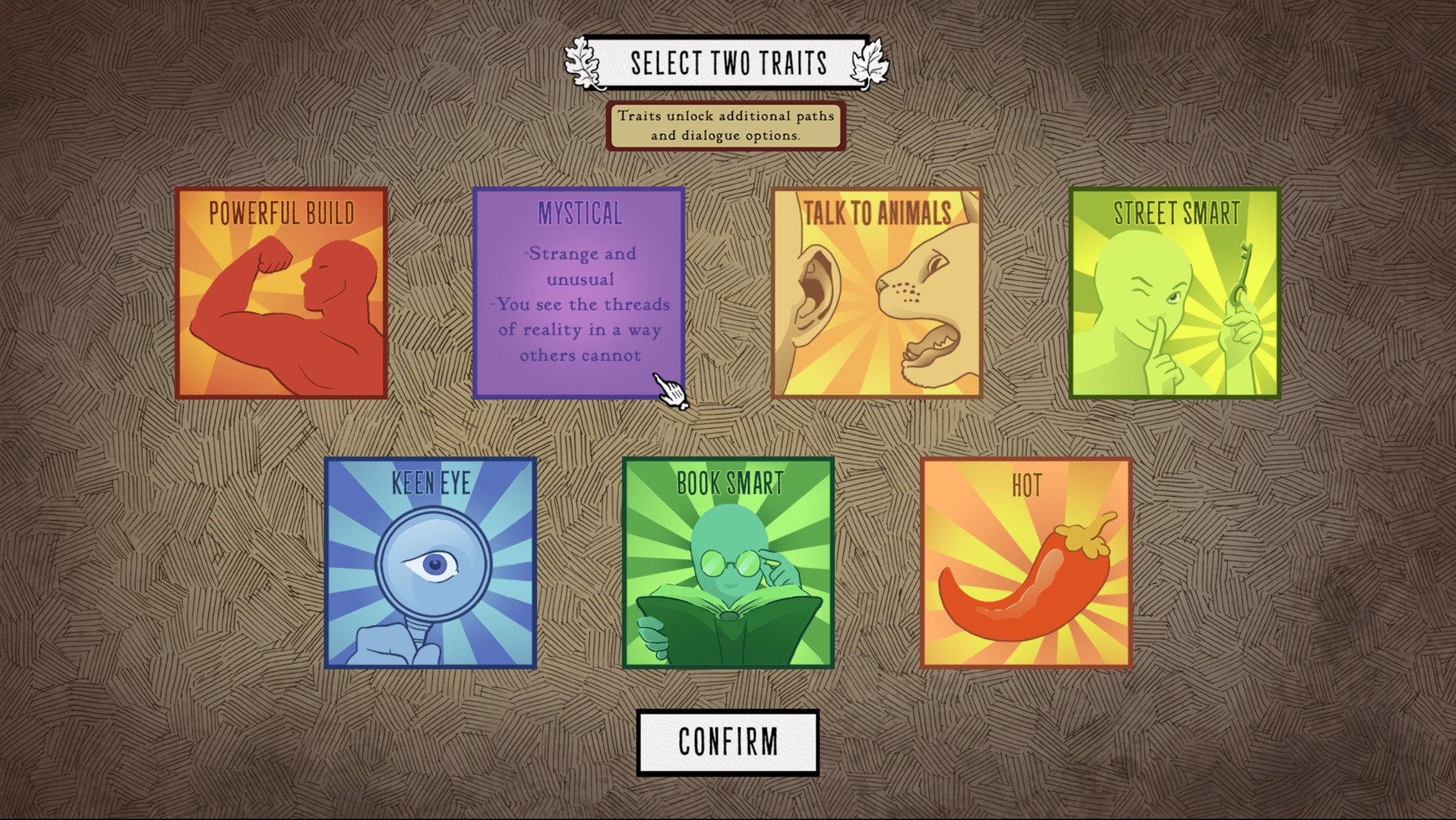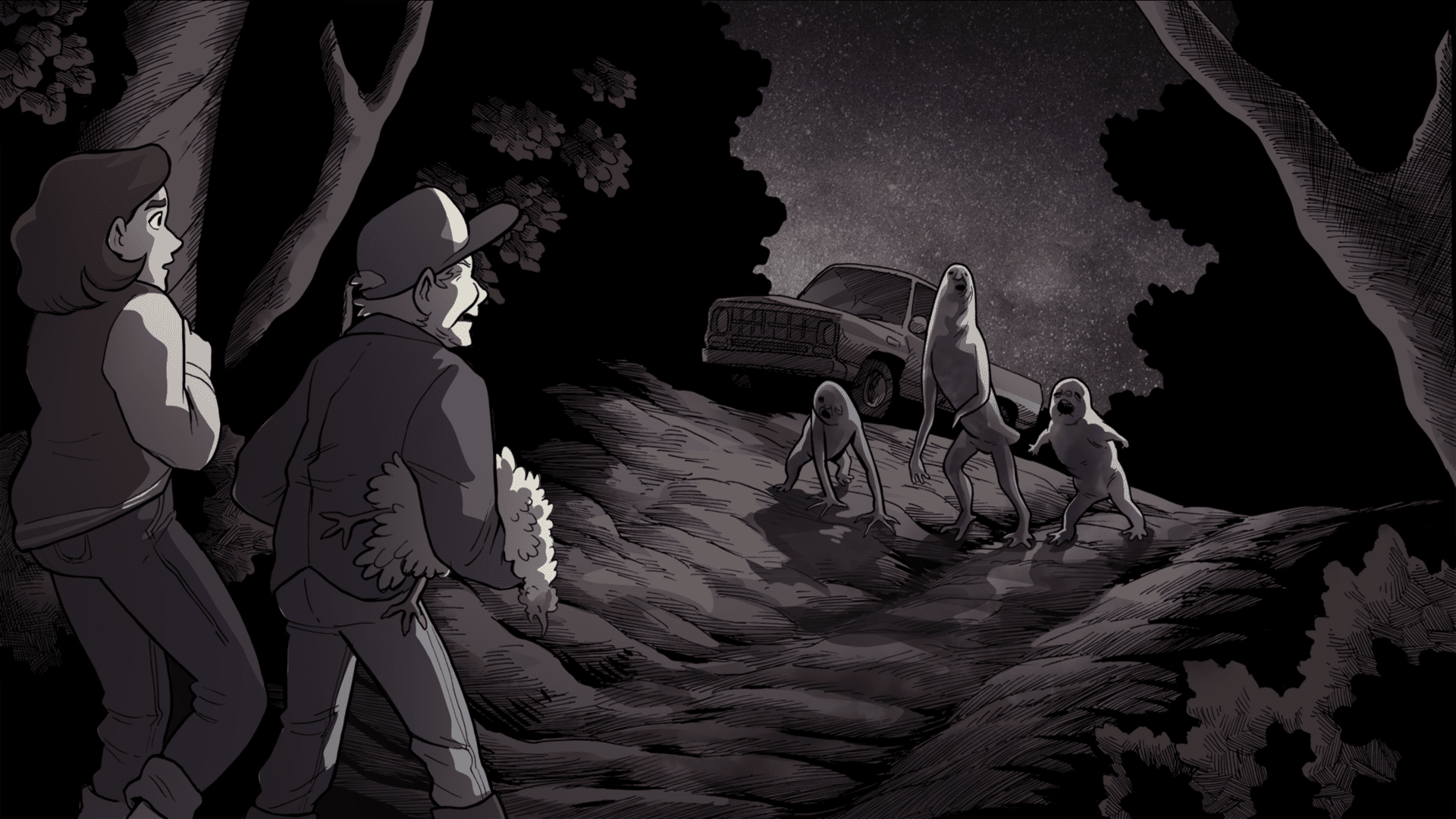
The Scarlet Hollow trait system takes it from a visual novel to a roleplay engine
There are a lot of things that make Black Tabby Games’ southern gothic horror visual novel Scarlet Hollow special. Its writing is exceptional, creating a compelling combination of pulp horror and small town slice-of-life that makes it the video game equivalent of a page turner. The characters you meet along the way are complex and have distinct personalities all their own. The art style is eerie and evocative of a time long past that hasn’t left this town behind. But the aspect of this game that has stood out the most to me is its RPG-esque trait system.

When you first start Scarlet Hollow, you’re asked to choose the pronouns you use, your name, the city you’re from, and most importantly, two personality/physical traits from a list of seven. These include Strong Build, Street Smart, Talk to Animals, Hot, Mystic, Book Smart, and Keen Eye. The names are fairly self-explanatory, and each provides a special skillset your character can use to navigate the trials and tribulations of their week in the small, North Carolina town of Scarlet Hollow. While this idea isn’t revolutionary — plenty of RPGs and tactics games allow you to choose one or multiple traits that give players certain advantages or abilities — the way Scarlet Hollow handles them in the context of a choose-your-own-adventure style visual novel is genuinely, well, novel.
It’s of course, not surprising that some of the inspiration for these traits came from massive RPGs like Divinity Original Sin and Fallout: New Vegas.
“Divinity just straight up has a couple of tags at character creation that open up new dialogue options for your characters, which I thought was super cool,” co-developer Tony Howard-Arias told Gayming. “And I also really, really loved in New Vegas that your stat array could actually influence how you engaged with the story. Because it felt like even beyond visual novels, so many RPGs like, how you built your character, would mostly just apply to combat and then there wouldn’t be interesting role playing or exploration abilities or ways to change the story based on how you built your character. So that seems like a kind of low investment way to personalize things to add replay value.”

Most games that claim that their choices matter usually have a hard time actually delivering on that promise, as scripted narratives still have to reach their predetermined plot points. But Scarlet Hollow’s trait system makes such a significant impact on the way your week unfolds that it builds an infrastructure for your choices to truly make a difference in what will happen. Each episode has a sort of “ideal” trait that will help you get the best possible ending for a chapter, and it changes with each episode, so you can never have a perfect build for the entire week. But whether or not you have certain traits will determine which clues you receive when, and ultimately who makes it out of each chapter unscathed.
Take Episode 1, for example. After arriving in the Holler, as it’s called, and meeting their cousin, the player character heads to town where they meet cryptid-hunting YouTuber Stella. She convinces the main character to accompany her on a night hike in search of the elusive skunk ape, but instead the two of you stumble upon actual monsters while in the forest. There’s no way to know it going in, but Strong Build is the trait you need to get everyone out of the woods safely at the end of this episode. When I played through Scarlet Hollow the first time, I happened to choose Hot and Strong Build as my traits. Without realizing it, I had chosen the trait that would give me the best ending for the first chapter, one where no one gets hurt. Playing through the episode again without that trait was then shocking, because boy is the outcome different.

With Strong Build, the player character is able to essentially make both choices in a sticky situation, allowing them to help the elderly hunter Duke shoot one of the monsters, while maintaining a tight grip on Stella’s pug Gretchen. Without an athletic body and quick reflexes, however, you’re simply not able to save both of them. Playing through with either dead, which is unfortunately the result of this choice, changes things irrevocably — though in Duke’s case we probably won’t see the full consequences of his absence until Episode 5 or beyond.
But these key choices aren’t the only aspect of the game that traits impact. As you make your way around the small town of Scarlet Hollow, you’re exposed to multiple threads and leads about the supernatural happenings going on. Depending on which traits you have, you will encounter different facts at different points throughout the game. Say you choose Talk to Animals as one of your traits. You will be clued in to several of the weird things happening around town much sooner than you would be otherwise thanks to your ability to chat with the local pets and wildlife. Alternatively, should you choose Mystic, you’ll be able to interact with the ooky spooky happenings in a much different way than a non-magically inclined person would be able to.
Based on your build, you will experience the story of Scarlet Hollow in a completely different way each time. Though each episode has set story beats it eventually has to hit, how you get there, what you notice along the way, and who ultimately walks away unscathed can vary wildly. This is clearly compelling for players as many (including myself) have now gone through multiple playthroughs.

“Something like 1% of our players have over 50 hours at this point, which is incredible,” Howard-Arias said. “Like 10% are at 20+.”
“I love it,” co-developer Abby Howard added. “The Trait system adds so much.”
That said, managing such a complex system isn’t an easy task for the developers at Black Tabby Games. Like a live-service game that features classes or weapons that impact gameplay, Scarlet Hollow has also experienced several balance changes, and continues to currently. An update to Episode 1 launched recently that added small scenes to the end of the chapter to help flesh it out more, for example.
“We’ve we’ve had a couple iterations of putting out balance patches because some traits have been severely under-picked compared to others,” Howard-Arias said.
“As only two people we tend to not be great at writing some of the traits because we ourselves have limited character traits as human beings,” Howard added.
The pair feel they have gotten better at writing and balancing these traits as they’ve continued working on Scarlet Hollow, and their audience’s enthusiasm for repeating chapters shows that they’re on the right track. By including these traits and having them be so impactful to the flow of Scarlet Hollow’s narrative, Black Tabby Games have created a visual novel that provides more role-playing options than ever before.







